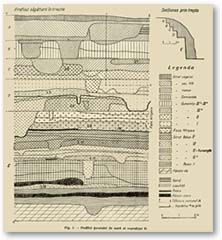1826 engraving representing Hârsova from the opposite shore of the Danube, to the right, next to the imposing fortified city, the artist has depicted the hill which probably corresponds to the Chalcolithic tell. (Engraving : Ermigny, in Adolphe Kunike, Wien, 1826, Biblioteca Academiei Române, Cabinetul de Stampe A.G. III 146/5577).
The importance and complexity of the site was originally brought to light by Doïna Galbenu who made public these first stratigraphic findings of the tell. (Doïna GALBENU 1962, Asezarea neolitica de la Hîrsova, Studii si Cercetari de Istorie Veche, anul XIII, 2 1962 :p. 285-306).
The Hârsova tell was discovered in 1960 following explorative survey carried out along the Danube. The first archaeological research there was by Doïna Galbenu (from 1961 to 1963, and then in 1971 and 1975) as a trench survey (region A) and a stratigraphic cut in the central region of the tell (12.5 meters deep) which revealed the richness and complexity of the archaeological find.
After an interruption in the work, the scientific research on this major Romanian site was resumed in 1985, and was realized by a team of specialist of The Romanian National History Museum (MNIR), and The National Museum of History and Archaeology at Constanta (MINAC).
Two areas of archaeological digs were begun (zone B and C), covering about 700sq. meters. Zone C, located at the east edge of the tell, was excavated down to the earliest ground level to examine the oldest remains. Zone B (including the survey of Doïna Galbenu) situated on the top of the tell, has been excavated, to the present day, reaching a depth in access of 4 meters. Since 1993, zone B has been the collaborative work of a French and Romanian team of scientists.
In addition to becoming an ongoing exchange of Romanian and French methodologies for optimizing the collection of stratigraphic and ethnographic data, this site, which has obtained the label of flagship of Romanian archaeological sites, has also become a privileged place of formation for the Romanian students of archaeology.


